
A boat is a watercraft of a large range of types and sizes, but generally smaller than a ship, which is distinguished by its larger size or capacity, its shape, or its ability to carry boats.

A kayak is a small, narrow human-powered watercraft typically propelled by means of a long, double-bladed paddle. The word kayak originates from the Inuktitut word qajaq. In British English, the kayak is also considered to be a kind of canoe.

William Ronald Reid Jr. was a Haida artist whose works include jewelry, sculpture, screen-printing, and paintings. Producing over one thousand original works during his fifty-year career, Reid is regarded as one of the most significant Northwest Coast artists of the late twentieth century.
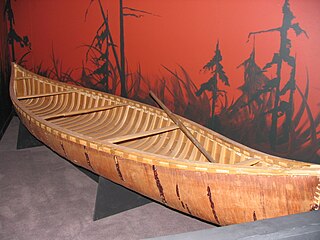
A canoe is a lightweight narrow water vessel, typically pointed at both ends and open on top, propelled by one or more seated or kneeling paddlers facing the direction of travel and using paddles.
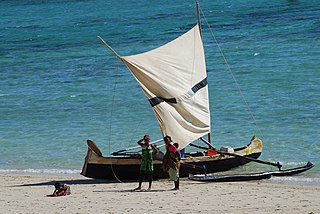
A pirogue, also called a piragua or piraga, is any of various small boats, particularly dugouts and native canoes. The word is French and is derived from Spanish piragua, which comes from the Carib piraua.
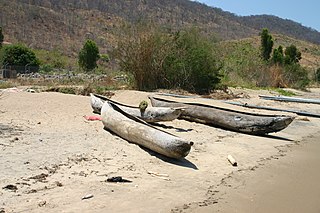
A dugout canoe or simply dugout is a boat made from a hollowed-out tree. Other names for this type of boat are logboat and monoxylon. Monoxylon (μονόξυλον) is Greek – mono- (single) + ξύλον xylon (tree) – and is mostly used in classic Greek texts. In German, they are called Einbaum. Some, but not all, pirogues are also constructed in this manner.
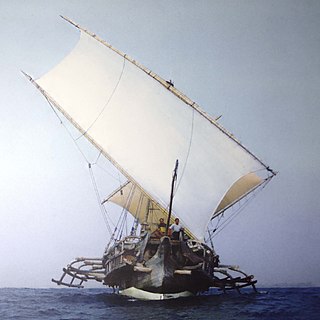
Outrigger boats are various watercraft featuring one or more lateral support floats known as outriggers, which are fastened to one or both sides of the main hull. They can range from small dugout canoes to large plank-built vessels. Outrigger boats can also vary in their configuration, from the ancestral double-hull configuration (catamarans), to single-outrigger vessels prevalent in the Pacific Islands and Madagascar, to the double-outrigger vessels (trimarans) prevalent in Island Southeast Asia. They are traditionally fitted with Austronesian sails, like the crab claw sails and tanja sails, but in modern times are often fitted with petrol engines.
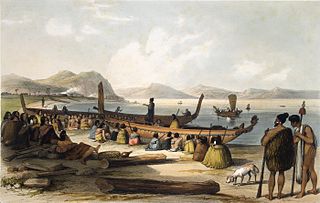
Waka are Māori watercraft, usually canoes ranging in size from small, unornamented canoes used for fishing and river travel to large, decorated war canoes up to 40 metres (130 ft) long.

A tepukei, tepuke or TePuke is a Polynesian boat type, characterized by its elaborate decking, its submerged hulls and symmetrical "crab claw" sail slender foil or radically extended tips claw sail. Tepukei boats are produced primarily by the Polynesian-speaking inhabitants of Taumako, and have been occasionally borrowed by other Polynesian and Melanesian societies.
Canoe sailing refers to the practice of fitting an Austronesian outrigger or Western canoe with sails.

The Spirit of Haida Gwaii is a sculpture by British Columbia Haida artist Bill Reid (1920–1998). There are two versions of it: the black canoe and the jade canoe. The black canoe features on Canadian $20 bills of the Canadian Journey series issued between 2004 and 2012.

The Walap is a traditional ocean-going sailing outrigger canoe from the Marshall Islands.
Michael Nicoll Yahgulanaas is a visual artist, author, and public speaker. His work has been seen in public spaces, museums, galleries and private collections across globe. Institutional collections include the British Museum, Metropolitan Museum of Art, Seattle Art Museum, Vancouver Art Gallery, and the Humboldt Forum.

Traditionally, many different kinds of boats have been used as fishing boats to catch fish in the sea, or on a lake or river. Even today, many traditional fishing boats are still in use. According to the United Nations Food and Agriculture Organization (FAO), at the end of 2004, the world fishing fleet consisted of about 4 million vessels, of which 2.7 million were undecked (open) boats. While nearly all decked vessels were mechanised, only one-third of the undecked fishing boats were powered, usually with outboard engines. The remaining 1.8 million boats were traditional craft of various types, operated by sail and oars.

Formline art is a feature in the Indigenous art of the Northwest Coast of North America, distinguished by the use of characteristic shapes referred to as ovoids, U forms and S forms. Coined by Bill Holm in his 1965 book Northwest Coast Indian Art: An Analysis of Form, the "formline is the primary design element on which Northwest Coast art depends, and by the turn of the 20th century, its use spread to the southern regions as well. It is the positive delineating force of the painting, relief and engraving. Formlines are continuous, flowing, curvilinear lines that turn, swell and diminish in a prescribed manner. They are used for figure outlines, internal design elements, and abstract compositions."

The Haida Heritage Centre is the premier cultural centre and museum of the Haida people. It is located in Skidegate, a community on Graham Island in Haida Gwaii off the Pacific coast of British Columbia, Canada. The centre is situated just south of the site of a historical village in Kay Llnagaay. The Centre was built and is managed by Gwaalagaa Naay, an economic development branch of the Skidegate Band Council, the owners of the site. It is one of the major aboriginal cultural tourism attractions in Haida Gwaii and has been described as "a place for the Haida voice to be heard." Educational programs are offered in partnership with School District 50 Haida Gwaii, the University of Northern British Columbia, and with the Haida Gwaii Higher Education Society.

Hlk'yah G̱awG̱a, also known as Windy Bay, is located on Athlii Gwaii in southern Haida Gwaii, British Columbia. The site was historically the location of a Haida village named Hlk'yah Llnagaay, meaning Peregrine Falcon Town in English. In the 1980s, Hlk'yah G̱awG̱a was the focus of a series of lawsuits and protests opposing clearcut logging on the island. These demonstrations were the impetus for the signing of the Gwaii Haanas Agreement of 1993 and the creation of the Gwaii Haanas National Park Reserve, National Marine Conservation Area Reserve, and Haida Heritage Site.
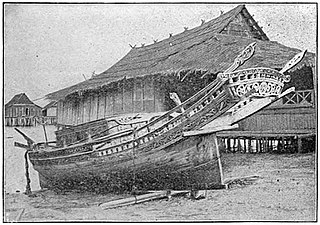
Lepa, also known as lipa or lepa-lepa, are indigenous ships of the Sama-Bajau people in Indonesia, the Philippines, and Malaysia. They were traditionally used as houseboats by the seagoing Sama Dilaut. Since most Sama have abandoned exclusive sea-living, modern lepa are instead used as fishing boats and cargo vessels.

The Raven and the First Men is a sculpture by Haida artist Bill Reid. It depicts the Haida creation myth. It was carved from a single block of laminated yellow cedar, beginning in the fall of 1978, and took two years to complete, with work completing on April 1, 1980. Raven and the First Men is depicted on the reverse of the former Canadian twenty dollar bill of the Canadian Journey series.

















